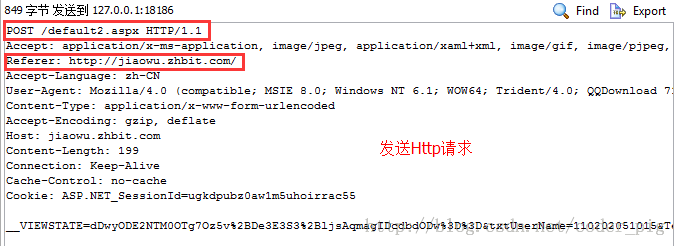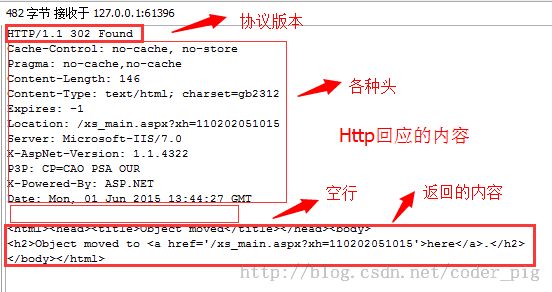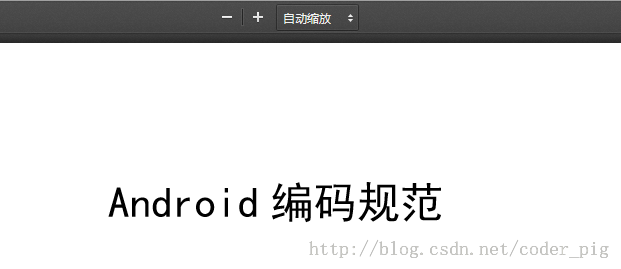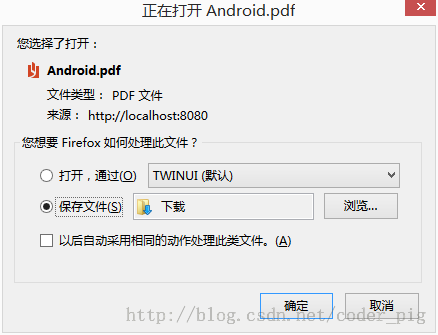# 7.1.2 Android Http請求頭與響應頭的學習
## 本節引言:
> 上節中我們對Android涉及的網絡編程進行了了解,也學習了下Http的基本概念,而本節我們 要學習的是Http的請求頭與響應頭,當然,可以把也可以把這節看作文檔,用到的時候來查查 即可!
## 1.HTTP請求之消息頭:
> 這里貼下上一節給出的圖,根據下面給出的表,大家自己感受下相關請求頭的作用吧: PS:第一行是請求行:請求方式 + 資源名稱 + HTTP協議版本號,另外請求頭只是給服務端的一個 信息而已或者說一個簡單,至于怎么處理,還是由服務端來決定的!
>
> 
### HTTP Request Header請求頭信息對照表:
| Header | 解釋 | 示例 |
| :-- | :-- | :-- |
| **Accept** | 指定客戶端能夠接收的內容類型 | Accept: text/plain, text/html |
| **Accept-Charset** | 瀏覽器可以接受的字符編碼集。 | Accept-Charset: iso-8859-5 |
| **Accept-Encoding** | 指定瀏覽器可以支持的web服務器返回內容壓縮編碼類型。 | Accept-Encoding: compress, gzip |
| **Accept-Language** | 瀏覽器可接受的語言 | Accept-Language: en,zh |
| **Accept-Ranges** | 可以請求網頁實體的一個或者多個子范圍字段 | Accept-Ranges: bytes |
| **Authorization** | HTTP授權的授權證書 | Authorization: Basic QWxhZGRpbjpvcGVuIHNlc2FtZQ== |
| **Cache-Control** | 指定請求和響應遵循的緩存機制 | Cache-Control: no-cache |
| **Connection** | 表示是否需要持久連接。(HTTP 1.1默認進行持久連接) | Connection: close |
| **Cookie** | HTTP請求發送時,會把保存在該請求域名下的所有cookie值一起發送給web服務器。 | Cookie: $Version=1; Skin=new; |
| **Content-Length** | 請求的內容長度 | Content-Length: 348 |
| **Content-Type** | 請求的與實體對應的MIME信息 | Content-Type: application/x-www-form-urlencoded |
| **Date** | 請求發送的日期和時間 | Date: Tue, 15 Nov 2010 08:12:31 GMT |
| **Expect** | 請求的特定的服務器行為 | Expect: 100-continue |
| **From** | 發出請求的用戶的Email | From: user@email.com |
| **Host** | 指定請求的服務器的域名和端口號 | Host: www.zcmhi.com |
| **If-Match** | 只有請求內容與實體相匹配才有效 | If-Match: "737060cd8c284d8af7ad3082f209582d" |
| **If-Modified-Since** | 如果請求的部分在指定時間之后被修改則請求成功,未被修改則返回304代碼 | If-Modified-Since: Sat, 29 Oct 2010 19:43:31 GMT |
| **If-None-Match** | 如果內容未改變返回304代碼,參數為服務器先前發送的Etag,與服務器回應的Etag比較判斷是否改變 | If-None-Match: "737060cd8c284d8af7ad3082f209582d" |
| **If-Range** | 如果實體未改變,服務器發送客戶端丟失的部分,否則發送整個實體。參數也為Etag | If-Range: "737060cd8c284d8af7ad3082f209582d" |
| **If-Unmodified-Since** | 只在實體在指定時間之后未被修改才請求成功 | If-Unmodified-Since: Sat, 29 Oct 2010 19:43:31 GMT |
| **Max-Forwards** | 限制信息通過代理和網關傳送的時間 | Max-Forwards: 10 |
| **Pragma** | 用來包含實現特定的指令 | Pragma: no-cache |
| **Proxy-Authorization** | 連接到代理的授權證書 | Proxy-Authorization: Basic QWxhZGRpbjpvcGVuIHNlc2FtZQ== |
| **Range** | 只請求實體的一部分,指定范圍 | Range: bytes=500-999 |
| **Referer** | 先前網頁的地址,當前請求網頁緊隨其后,即來路 | Referer: http://blog.csdn.net/coder_pig |
| **TE** | 客戶端愿意接受的傳輸編碼,并通知服務器接受接受尾加頭信息 | TE: trailers,deflate;q=0.5 |
| **Upgrade** | 向服務器指定某種傳輸協議以便服務器進行轉換(如果支持) | Upgrade: HTTP/2.0, SHTTP/1.3, IRC/6.9, RTA/x11 |
| **User-Agent** | User-Agent的內容包含發出請求的用戶信息 | User-Agent: Mozilla/5.0 (Linux; X11) |
| **Via** | 通知中間網關或代理服務器地址,通信協議 | Via: 1.0 fred, 1.1 nowhere.com (Apache/1.1) |
| **Warning** | 關于消息實體的警告信息 | Warn: 199 Miscellaneous warning |
## 2.HTTP響應之響應頭:
> 同樣給出上節的圖: PS:第一行依次是:協議版本號 狀態碼 302表示這里沒有,但是另外一個地方有,通過Location頁面重定向了
>
> 
### HTTP Responses Header 響應頭信息對照表:
| Header | 解釋 | 示例 |
| :-- | :-- | :-- |
| **Accept-Ranges** | 表明服務器是否支持指定范圍請求及哪種類型的分段請求 | Accept-Ranges: bytes |
| **Age** | 從原始服務器到代理緩存形成的估算時間(以秒計,非負) | Age: 12 |
| **Allow** | 對某網絡資源的有效的請求行為,不允許則返回405 | Allow: GET, HEAD |
| **Cache-Control** | 告訴所有的緩存機制是否可以緩存及哪種類型 | Cache-Control: no-cache |
| **Content-Encoding** | web服務器支持的返回內容壓縮編碼類型 | Content-Encoding: gzip |
| **Content-Language** | 響應體的語言 | Content-Language: en,zh |
| **Content-Length** | 響應體的長度 | Content-Length: 348 |
| **Content-Location** | 請求資源可替代的備用的另一地址 | Content-Location: /index.htm |
| **Content-MD5** | 返回資源的MD5校驗值 | Content-MD5: Q2hlY2sgSW50ZWdyaXR5IQ== |
| **Content-Range** | 在整個返回體中本部分的字節位置 | Content-Range: bytes 21010-47021/47022 |
| **Content-Type** | 返回內容的MIME類型 | Content-Type: text/html; charset=utf-8 |
| **Date** | 原始服務器消息發出的時間 | Date: Tue, 15 Nov 2010 08:12:31 GMT |
| **ETag** | 請求變量的實體標簽的當前值 | ETag: "737060cd8c284d8af7ad3082f209582d" |
| **Expires** | 響應過期的日期和時間 | Expires: Thu, 01 Dec 2010 16:00:00 GMT |
| **Last-Modified** | 請求資源的最后修改時間 | Last-Modified: Tue, 15 Nov 2010 12:45:26 GMT |
| **Location** | 用來重定向接收方到非請求URL的位置來完成請求或標識新的資源 | Location: http://blog.csdn.net/coder_pig |
| **Pragma** | 包括實現特定的指令,它可應用到響應鏈上的任何接收方 | Pragma: no-cache |
| **Proxy-Authenticate** | 它指出認證方案和可應用到代理的該URL上的參數 | Proxy-Authenticate: Basic |
## 3.代碼驗證響應頭的作用:
> 好了,看了那么多概念的東西,不動動手怎么行呢?是吧,那我們就寫一些簡單的代碼來驗證一些 常用的響應頭的作用吧,以便加深我們的了解,這里的話服務端就用最簡單的Servlet來實現,如果不會 Java Web的朋友只需將代碼拷一拷,配置下web.xml,把Servlet的類名扣上,比如:
```
<servlet> <servlet-name>FirstServlet</servlet-name> <servlet-class>com.jay.server.FirstServlet</servlet-class> </servlet> <servlet-mapping> <servlet-name>FirstServlet</servlet-name> <url-pattern>/FirstServlet</url-pattern> </servlet-mapping>
```
改成對應的類名即可!
### 1)通過Location實現頁面重定向
**實現代碼**:
```
package com.jay.http.test; import java.io.IOException; import javax.servlet.ServletException; import javax.servlet.http.HttpServlet; import javax.servlet.http.HttpServletRequest; import javax.servlet.http.HttpServletResponse; public class ServletOne extends HttpServlet { @Override protected void doGet(HttpServletRequest req, HttpServletResponse resp) throws ServletException, IOException { //告訴瀏覽器響應碼,以及重定向頁面 resp.setStatus(302); resp.setHeader("Location", "http://www.baidu.com"); } @Override protected void doPost(HttpServletRequest req, HttpServletResponse resp) throws ServletException, IOException { this.doGet(req, resp); } }
```
**運行結果**:
當我們去訪問:http://localhost:8080/HttpTest/ServletOne的時候,我們會發現頁面跳轉到了百度, 接著我們用FireFox的開發者工具:可以看到我們發出的HTTP的內容:

### 2)通過Content-Encoding告訴瀏覽器數據的壓縮格式
**實現代碼:**
```
package com.jay.http.test; import java.io.ByteArrayOutputStream; import java.io.IOException; import java.util.zip.GZIPOutputStream; import javax.servlet.ServletException; import javax.servlet.http.HttpServlet; import javax.servlet.http.HttpServletRequest; import javax.servlet.http.HttpServletResponse; public class ServletTwo extends HttpServlet { @Override protected void doGet(HttpServletRequest req, HttpServletResponse resp) throws ServletException, IOException { String data = "Fresh air and sunshine can have an amazing effect on our feelings. " + "Sometimes when we are feeling down, all that we need to do is simply to go " + "outside and breathe. Movement and exercise is also a fantastic way to feel better. " + "Positive emotions can be generated by motion. So if we start to feel down," + " take some deep breathes, go outside, feel the fresh air, " + "let the sun hit our face, go for a hike, a walk, a bike ride, " + "a swim, a run, whatever. We will feel better if we do this."; System.out.println("原始數據長度:" + data.getBytes().length); // 對數據進行壓縮: ByteArrayOutputStream bout = new ByteArrayOutputStream(); GZIPOutputStream gout = new GZIPOutputStream(bout); gout.write(data.getBytes()); gout.close(); // 得到壓縮后的數據 byte gdata[] = bout.toByteArray(); resp.setHeader("Content-Encoding", "gzip"); resp.setHeader("Content-Length", gdata.length + ""); resp.getOutputStream().write(gdata); } protected void doPost(HttpServletRequest req, HttpServletResponse resp) throws ServletException, IOException { doGet(req, resp); }; }
```
**運行結果**:
控制臺輸出:

瀏覽器輸出:

再看看我們的HTTP內容:


這個**gzip**壓縮字符串對于簡單的字符串壓縮,效率不高,比如小豬本來寫的是一個一首靜夜詩的字符串, 后來發現壓縮過后的大小,竟然比原先的還要大=-=...
### 3)通過content-type,設置返回的數據類型
> 服務端返回的有時可能是一個text/html,有時也可能是一個image/jpeg,又或者是一段視頻video/avi 瀏覽器可以根據這個對應的數據類型,然后以不同的方式將數據顯示出來!好吧,這里我們弄一個讀PDF的
**實現代碼**:
```
package com.jay.http.test; import java.io.IOException; import java.io.InputStream; import java.io.OutputStream; import javax.servlet.ServletException; import javax.servlet.http.HttpServlet; import javax.servlet.http.HttpServletRequest; import javax.servlet.http.HttpServletResponse; public class ServletThree extends HttpServlet { @Override protected void doGet(HttpServletRequest req, HttpServletResponse resp) throws ServletException, IOException { resp.setHeader("content-type", "application/pdf"); InputStream in = this.getServletContext().getResourceAsStream("/file/android編碼規范.pdf"); byte buffer[] = new byte[1024]; int len = 0; OutputStream out = resp.getOutputStream(); while((len = in.read(buffer)) > 0) { out.write(buffer,0,len); } } protected void doPost(HttpServletRequest req, HttpServletResponse resp) throws ServletException ,IOException { doGet(req, resp); }; }
```
**運行結果:**
在瀏覽器上輸入:http://localhost:8080/HttpTest/ServletThree
好噠,果然可以讀到PDF了,對了,這個PDF我已經丟在webroot的file目錄下,不然會報空指針哦~:
當然,你也可以試著去播放一段音樂或者視頻,只需修改下content-type這個參數而已
下面順便給出個HTTP Content-type的對照表吧: [HTTP Content-type的對照表](http://www.runoob.com/http/http-content-type.html)

### 4)通過refresh響應頭,讓瀏覽器隔幾秒后跳轉至別的頁面
恩呢,一般我們可能有這樣的需求,比如每隔幾秒刷新一次頁面,又或者加載某個頁面幾秒后 又跳轉至另一個頁面,那么refresh可以滿足你的需要~
**實現代碼:**
```
package com.jay.http.test; import java.io.IOException; import javax.servlet.ServletException; import javax.servlet.http.HttpServlet; import javax.servlet.http.HttpServletRequest; import javax.servlet.http.HttpServletResponse; public class ServletFour extends HttpServlet { public int second = 0; @Override protected void doGet(HttpServletRequest req, HttpServletResponse resp) throws ServletException, IOException { //1.瀏覽器每隔2秒定時刷新頁面 // resp.setHeader("refresh", "2"); // resp.getWriter().write(++second + ""); // System.out.println("doGet方法被調用~"); //2.進入頁面5s后,然頁跳到百度~ resp.setHeader("refresh", "5;url='http://www.baidu.com'"); resp.getWriter().write("HE HE DA~"); } protected void doPost(HttpServletRequest req, HttpServletResponse resp) throws ServletException ,IOException { doGet(req, resp); }; }
```
**運行結果**:
> * 1的話每隔2秒刷新一次頁面,我們可以看到顯示的數字是遞增的,另外doGet方法也一直被調用, 說明頁面真的是刷新的!
> * 2的話進入頁面后5s,就自己跳轉到百度了~
### 5)通過content-dispostion響應頭,讓瀏覽器下載文件
> 這個很簡單,我們只需把③中設置Content-type的一行去掉,然后加上: **resp.setHeader("content-disposition", "attachment;filename=Android.pdf");**
**實現代碼**:
```
package com.jay.http.test; import java.io.IOException; import java.io.InputStream; import java.io.OutputStream; import javax.servlet.ServletException; import javax.servlet.http.HttpServlet; import javax.servlet.http.HttpServletRequest; import javax.servlet.http.HttpServletResponse; public class ServletFive extends HttpServlet { @Override protected void doGet(HttpServletRequest req, HttpServletResponse resp) throws ServletException, IOException { resp.setHeader("content-disposition", "attachment;filename=Android.pdf"); InputStream in = this.getServletContext().getResourceAsStream("/file/android編碼規范.pdf"); byte buffer[] = new byte[1024]; int len = 0; OutputStream out = resp.getOutputStream(); while((len = in.read(buffer)) > 0) { out.write(buffer,0,len); } } @Override protected void doPost(HttpServletRequest req, HttpServletResponse resp) throws ServletException, IOException { doGet(req, resp); } }
```
**運行結果**:

## 本節小結:
> 本節給大家介紹了Http中的請求頭和響應頭,也寫了幾個關于響應頭調瀏覽器的一些示例, 相信經過本章,大家對于Http協議更加了解了,下節我們來學習Android給我們提供的Http 請求方式:HttpURLConnection!好的,本節就到這里,謝謝~ 對了,本節demo下載:[下載 HttpTest.zip](/try/download/HttpTest.zip)
- 1.0 Android基礎入門教程
- 1.0.1 2015年最新Android基礎入門教程目錄
- 1.1 背景相關與系統架構分析
- 1.2 開發環境搭建
- 1.2.1 使用Eclipse + ADT + SDK開發Android APP
- 1.2.2 使用Android Studio開發Android APP
- 1.3 SDK更新不了問題解決
- 1.4 Genymotion模擬器安裝
- 1.5.1 Git使用教程之本地倉庫的基本操作
- 1.5.2 Git之使用GitHub搭建遠程倉庫
- 1.6 .9(九妹)圖片怎么玩
- 1.7 界面原型設計
- 1.8 工程相關解析(各種文件,資源訪問)
- 1.9 Android程序簽名打包
- 1.11 反編譯APK獲取代碼&資源
- 2.1 View與ViewGroup的概念
- 2.2.1 LinearLayout(線性布局)
- 2.2.2 RelativeLayout(相對布局)
- 2.2.3 TableLayout(表格布局)
- 2.2.4 FrameLayout(幀布局)
- 2.2.5 GridLayout(網格布局)
- 2.2.6 AbsoluteLayout(絕對布局)
- 2.3.1 TextView(文本框)詳解
- 2.3.2 EditText(輸入框)詳解
- 2.3.3 Button(按鈕)與ImageButton(圖像按鈕)
- 2.3.4 ImageView(圖像視圖)
- 2.3.5.RadioButton(單選按鈕)&Checkbox(復選框)
- 2.3.6 開關按鈕ToggleButton和開關Switch
- 2.3.7 ProgressBar(進度條)
- 2.3.8 SeekBar(拖動條)
- 2.3.9 RatingBar(星級評分條)
- 2.4.1 ScrollView(滾動條)
- 2.4.2 Date & Time組件(上)
- 2.4.3 Date & Time組件(下)
- 2.4.4 Adapter基礎講解
- 2.4.5 ListView簡單實用
- 2.4.6 BaseAdapter優化
- 2.4.7ListView的焦點問題
- 2.4.8 ListView之checkbox錯位問題解決
- 2.4.9 ListView的數據更新問題
- 2.5.0 構建一個可復用的自定義BaseAdapter
- 2.5.1 ListView Item多布局的實現
- 2.5.2 GridView(網格視圖)的基本使用
- 2.5.3 Spinner(列表選項框)的基本使用
- 2.5.4 AutoCompleteTextView(自動完成文本框)的基本使用
- 2.5.5 ExpandableListView(可折疊列表)的基本使用
- 2.5.6 ViewFlipper(翻轉視圖)的基本使用
- 2.5.7 Toast(吐司)的基本使用
- 2.5.8 Notification(狀態欄通知)詳解
- 2.5.9 AlertDialog(對話框)詳解
- 2.6.0 其他幾種常用對話框基本使用
- 2.6.1 PopupWindow(懸浮框)的基本使用
- 2.6.2 菜單(Menu)
- 2.6.3 ViewPager的簡單使用
- 2.6.4 DrawerLayout(官方側滑菜單)的簡單使用
- 3.1.1 基于監聽的事件處理機制
- 3.2 基于回調的事件處理機制
- 3.3 Handler消息傳遞機制淺析
- 3.4 TouchListener PK OnTouchEvent + 多點觸碰
- 3.5 監聽EditText的內容變化
- 3.6 響應系統設置的事件(Configuration類)
- 3.7 AnsyncTask異步任務
- 3.8 Gestures(手勢)
- 4.1.1 Activity初學乍練
- 4.1.2 Activity初窺門徑
- 4.1.3 Activity登堂入室
- 4.2.1 Service初涉
- 4.2.2 Service進階
- 4.2.3 Service精通
- 4.3.1 BroadcastReceiver牛刀小試
- 4.3.2 BroadcastReceiver庖丁解牛
- 4.4.2 ContentProvider再探——Document Provider
- 4.5.1 Intent的基本使用
- 4.5.2 Intent之復雜數據的傳遞
- 5.1 Fragment基本概述
- 5.2.1 Fragment實例精講——底部導航欄的實現(方法1)
- 5.2.2 Fragment實例精講——底部導航欄的實現(方法2)
- 5.2.3 Fragment實例精講——底部導航欄的實現(方法3)
- 5.2.4 Fragment實例精講——底部導航欄+ViewPager滑動切換頁面
- 5.2.5 Fragment實例精講——新聞(購物)類App列表Fragment的簡單實現
- 6.1 數據存儲與訪問之——文件存儲讀寫
- 6.2 數據存儲與訪問之——SharedPreferences保存用戶偏好參數
- 6.3.1 數據存儲與訪問之——初見SQLite數據庫
- 6.3.2 數據存儲與訪問之——又見SQLite數據庫
- 7.1.1 Android網絡編程要學的東西與Http協議學習
- 7.1.2 Android Http請求頭與響應頭的學習
- 7.1.3 Android HTTP請求方式:HttpURLConnection
- 7.1.4 Android HTTP請求方式:HttpClient
- 7.2.1 Android XML數據解析
- 7.2.2 Android JSON數據解析
- 7.3.1 Android 文件上傳
- 7.3.2 Android 文件下載(1)
- 7.3.3 Android 文件下載(2)
- 7.4 Android 調用 WebService
- 7.5.1 WebView(網頁視圖)基本用法
- 7.5.2 WebView和JavaScrip交互基礎
- 7.5.3 Android 4.4后WebView的一些注意事項
- 7.5.4 WebView文件下載
- 7.5.5 WebView緩存問題
- 7.5.6 WebView處理網頁返回的錯誤碼信息
- 7.6.1 Socket學習網絡基礎準備
- 7.6.2 基于TCP協議的Socket通信(1)
- 7.6.3 基于TCP協議的Socket通信(2)
- 7.6.4 基于UDP協議的Socket通信
- 8.1.1 Android中的13種Drawable小結 Part 1
- 8.1.2 Android中的13種Drawable小結 Part 2
- 8.1.3 Android中的13種Drawable小結 Part 3
- 8.2.1 Bitmap(位圖)全解析 Part 1
- 8.2.2 Bitmap引起的OOM問題
- 8.3.1 三個繪圖工具類詳解
- 8.3.2 繪圖類實戰示例
- 8.3.3 Paint API之—— MaskFilter(面具)
- 8.3.4 Paint API之—— Xfermode與PorterDuff詳解(一)
- 8.3.5 Paint API之—— Xfermode與PorterDuff詳解(二)
- 8.3.6 Paint API之—— Xfermode與PorterDuff詳解(三)
- 8.3.7 Paint API之—— Xfermode與PorterDuff詳解(四)
- 8.3.8 Paint API之—— Xfermode與PorterDuff詳解(五)
- 8.3.9 Paint API之—— ColorFilter(顏色過濾器)(1/3)
- 8.3.10 Paint API之—— ColorFilter(顏色過濾器)(2-3)
- 8.3.11 Paint API之—— ColorFilter(顏色過濾器)(3-3)
- 8.3.12 Paint API之—— PathEffect(路徑效果)
- 8.3.13 Paint API之—— Shader(圖像渲染)
- 8.3.14 Paint幾個枚舉/常量值以及ShadowLayer陰影效果
- 8.3.15 Paint API之——Typeface(字型)
- 8.3.16 Canvas API詳解(Part 1)
- 8.3.17 Canvas API詳解(Part 2)剪切方法合集
- 8.3.18 Canvas API詳解(Part 3)Matrix和drawBitmapMash
- 8.4.1 Android動畫合集之幀動畫
- 8.4.2 Android動畫合集之補間動畫
- 8.4.3 Android動畫合集之屬性動畫-初見
- 8.4.4 Android動畫合集之屬性動畫-又見
- 9.1 使用SoundPool播放音效(Duang~)
- 9.2 MediaPlayer播放音頻與視頻
- 9.3 使用Camera拍照
- 9.4 使用MediaRecord錄音
- 10.1 TelephonyManager(電話管理器)
- 10.2 SmsManager(短信管理器)
- 10.3 AudioManager(音頻管理器)
- 10.4 Vibrator(振動器)
- 10.5 AlarmManager(鬧鐘服務)
- 10.6 PowerManager(電源服務)
- 10.7 WindowManager(窗口管理服務)
- 10.8 LayoutInflater(布局服務)
- 10.9 WallpaperManager(壁紙管理器)
- 10.10 傳感器專題(1)——相關介紹
- 10.11 傳感器專題(2)——方向傳感器
- 10.12 傳感器專題(3)——加速度/陀螺儀傳感器
- 10.12 傳感器專題(4)——其他傳感器了解
- 10.14 Android GPS初涉
- 11.0《2015最新Android基礎入門教程》完結散花~
